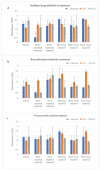Analysis of Sanitizer Rotation on the Susceptibility, Biofilm Forming Ability and Caco-2 Cell Adhesion and Invasion of Listeria
- PMID: 36145393
- PMCID: PMC9502273
- DOI: 10.3390/pathogens11090961
Analysis of Sanitizer Rotation on the Susceptibility, Biofilm Forming Ability and Caco-2 Cell Adhesion and Invasion of Listeria
Abstract
The purpose of this study was to determine the effect of sanitizer use conditions on the susceptibility, biofilm forming ability and pathogenicity of Listeria monocytogenes. Two different strains of L. monocytogenes and a non-pathogenic L. innocua were exposed to sodium hypochlorite, benzalkonium chloride and peroxyacetic acid at different concentrations (4 to 512 ppm) and treatment times (30 s to 5 min), respectively. Under the tested conditions, no significant difference (p > 0.05) in reduction was observed among the three tested sanitizers. A reduction of 1 to 8 log CFU/mL was observed depending upon the sanitizer concentration and treatment times. The survived cells at the highest sublethal concentration and treatment time of a particular sanitizer upon re-exposure to the same or different sanitizer showed either no change or increased susceptibility when compared to parent strains. Upon repeated exposure to sanitizers at progressively increasing concentrations from 1 to 128 ppm, L. innocua was able to survive concentrations of up to 32 ppm benzalkonium chloride and 64 ppm peroxyacetic acid treatments, respectively. At the tested sub-lethal concentrations, no significant difference (p > 0.05) in biofilm formation was observed among the tested strains. Caco-2 interaction with L. innocua showed a reduction in invasion ability with sublethal concentrations of sanitizers.
Keywords: Listeria monocytogenes; biofilm; pathogenicity; repeated exposure; resistance; sanitizers.
Conflict of interest statement
The authors declare no conflict of interest.
Figures

 represent treatment times of 30 s, 1, 2.5, and 5 min, respectively.
represent treatment times of 30 s, 1, 2.5, and 5 min, respectively.


References
-
- Adrião A., Vieira M., Fernandes I., Barbosa M., Sol M., Tenreiro R.P., Chambel L., Barata B., Zilhao I., Shama G., et al. Marked intra-strain variation in response of Listeria monocytogenes dairy isolates to acid or salt stress and the effect of acid or salt adaptation on adherence to abiotic surfaces. Int. J. Food Microbiol. 2008;123:142–150. doi: 10.1016/j.ijfoodmicro.2007.12.016. - DOI - PubMed
Grants and funding
LinkOut - more resources
Full Text Sources
Molecular Biology Databases

